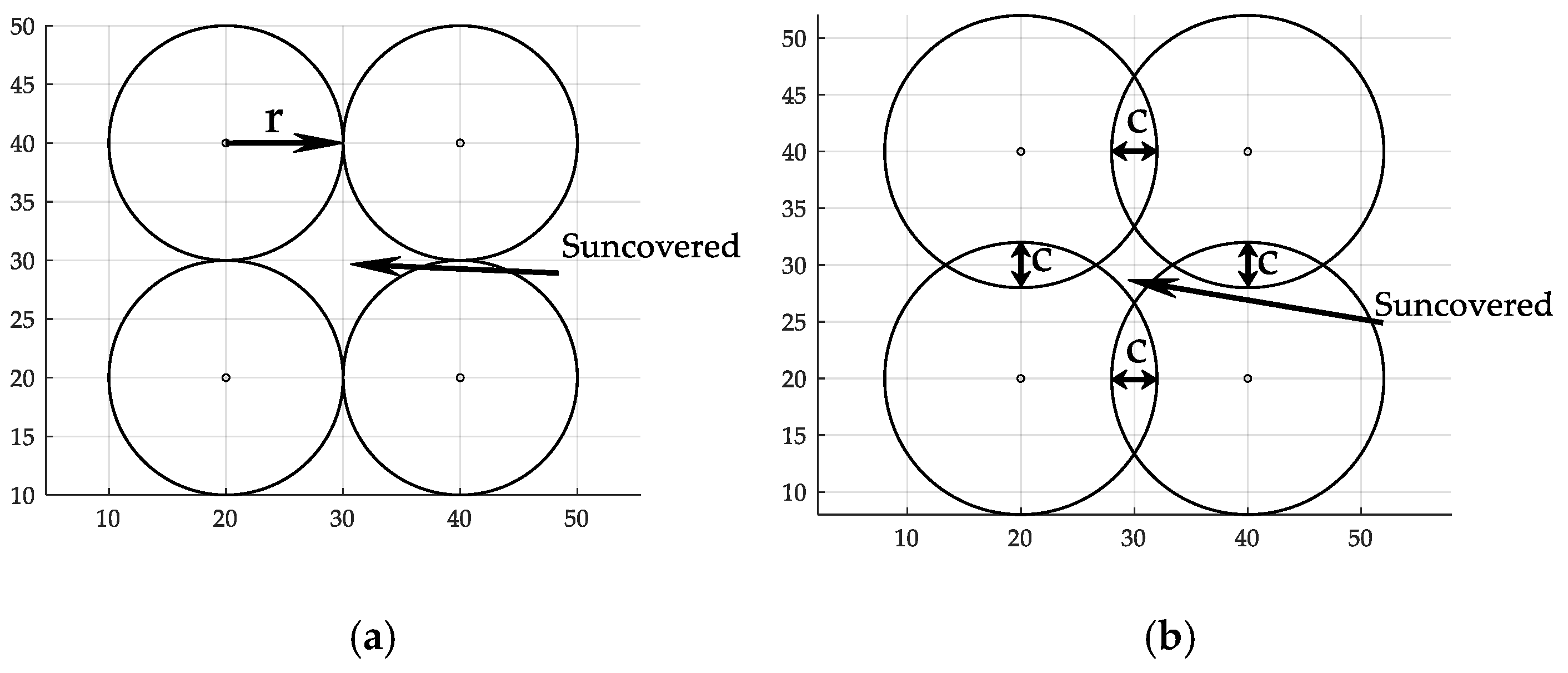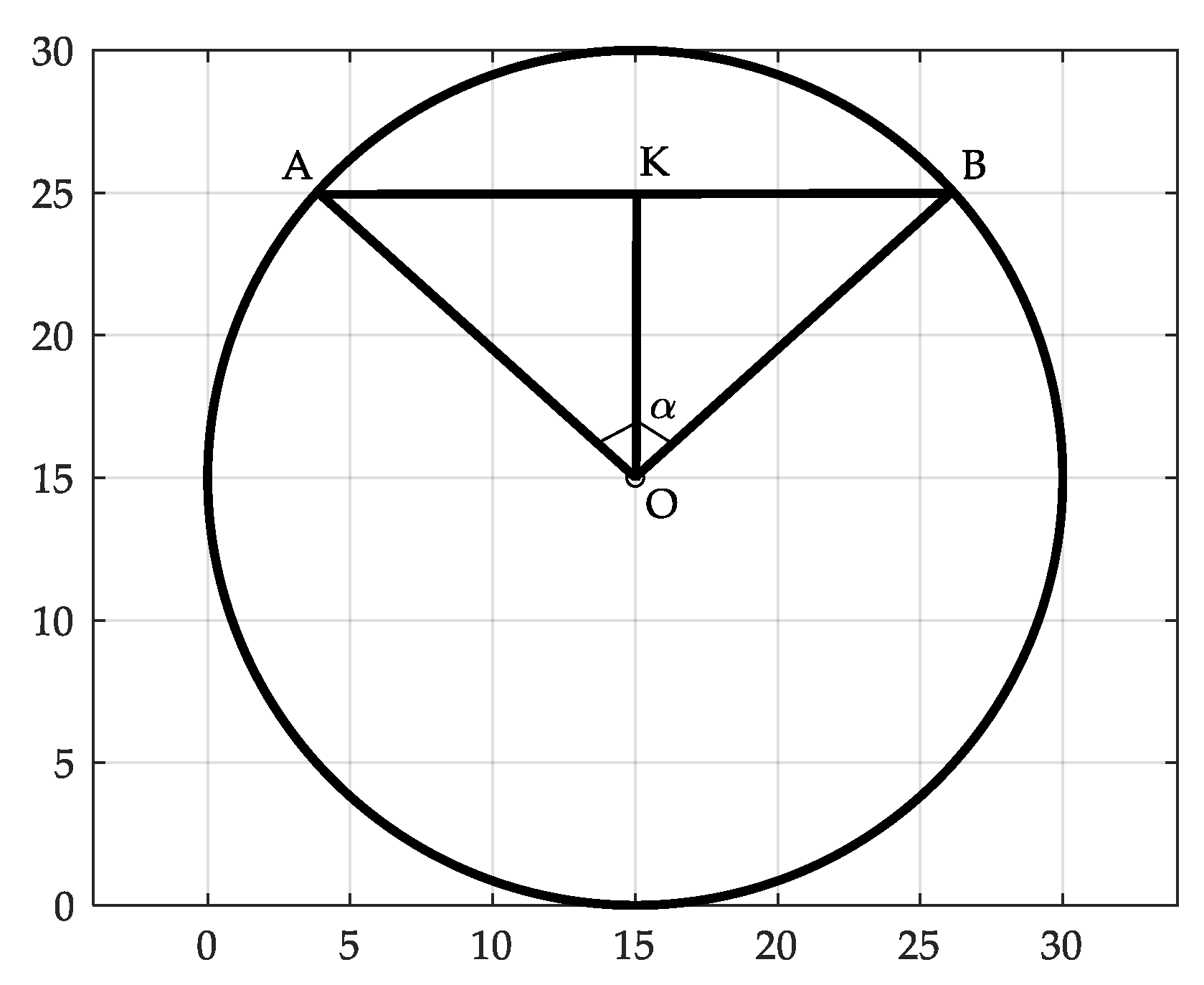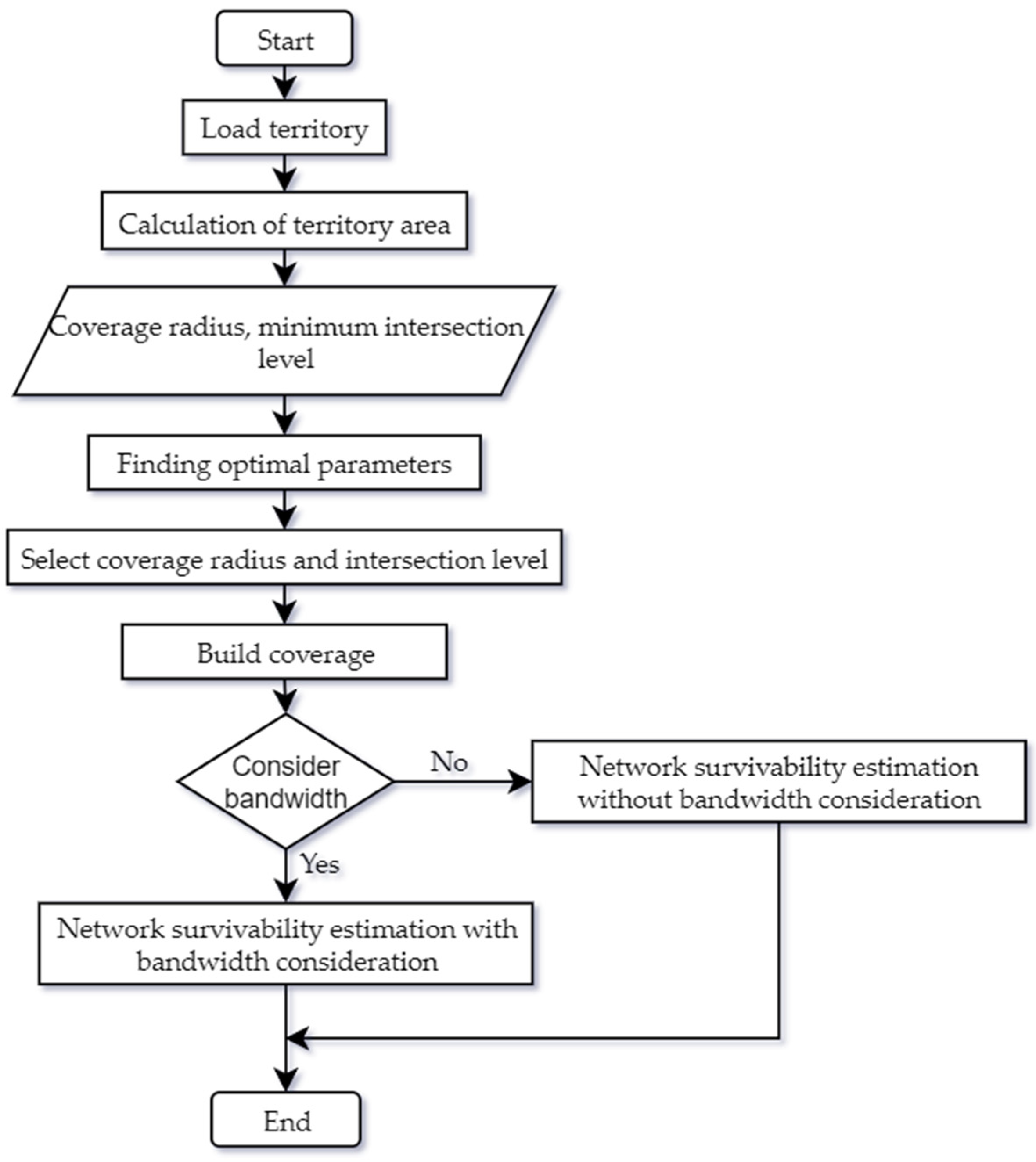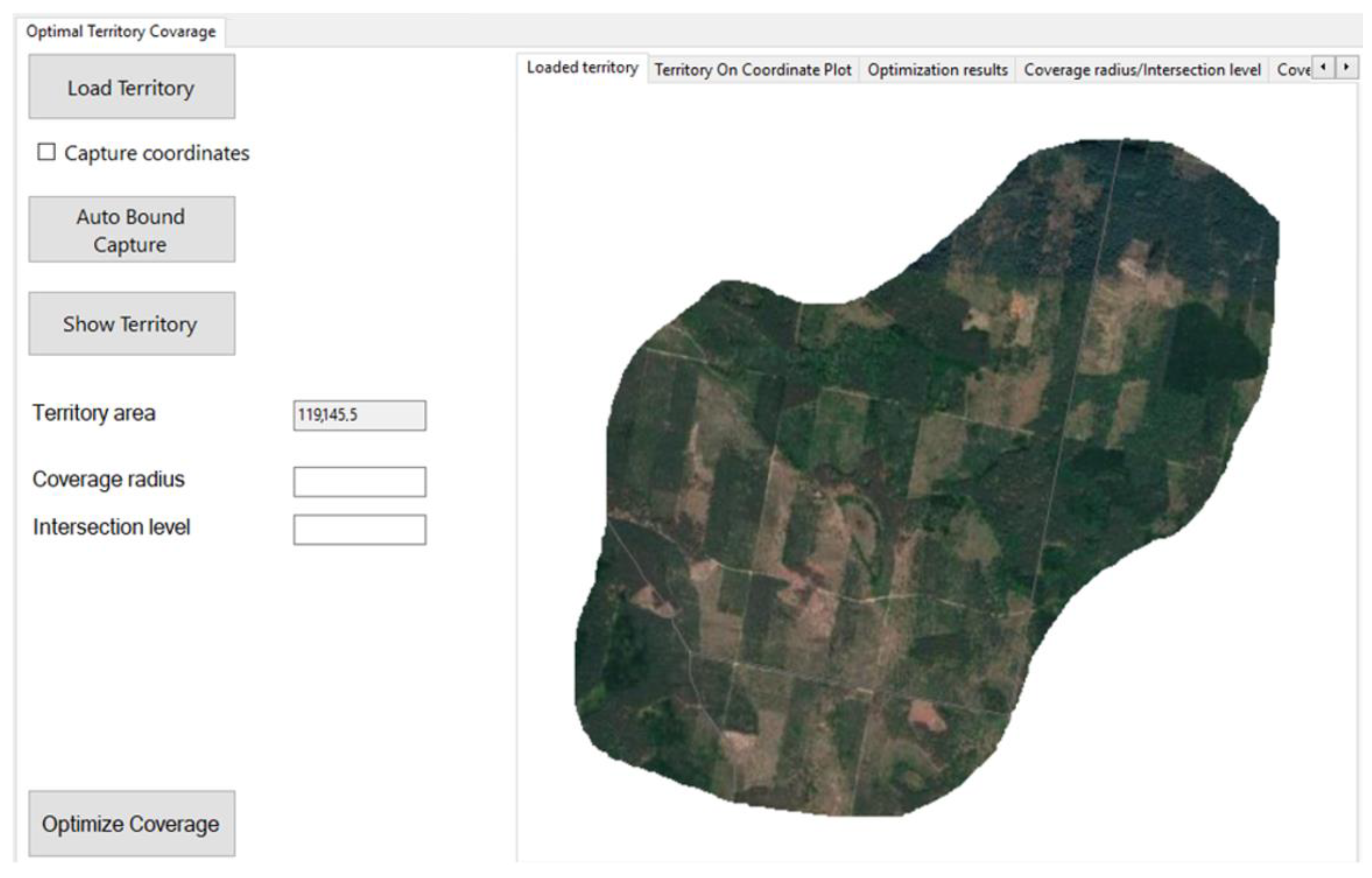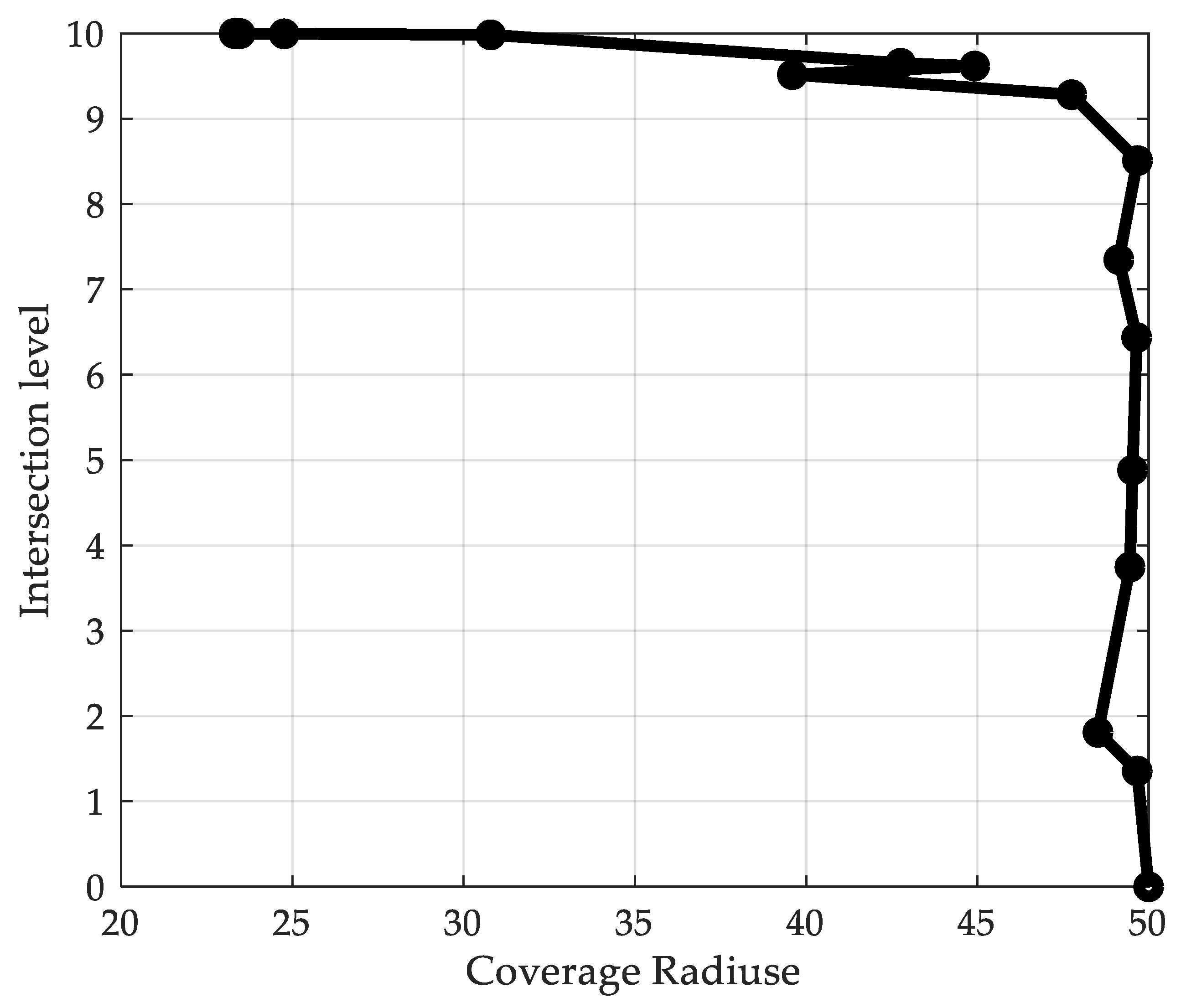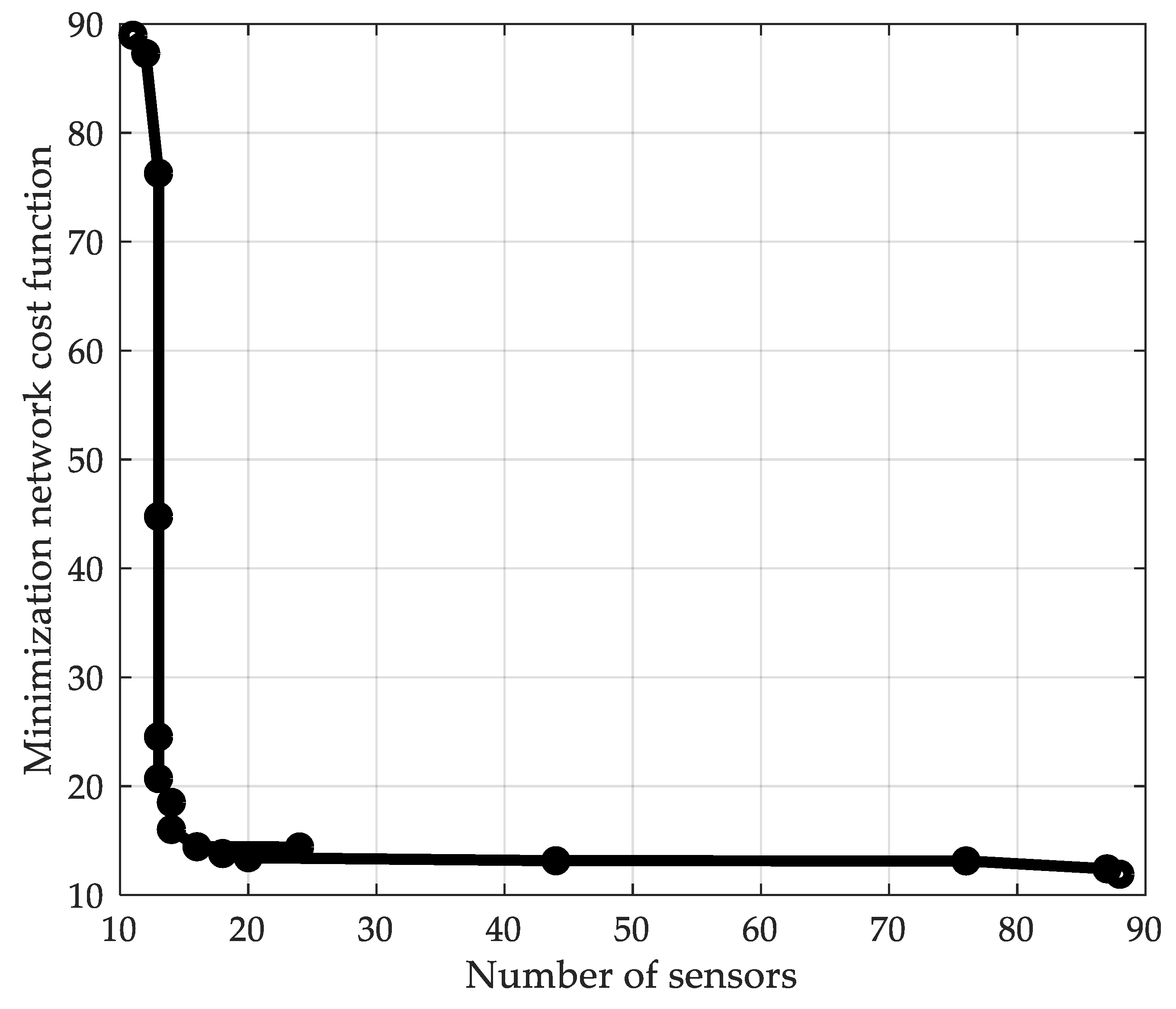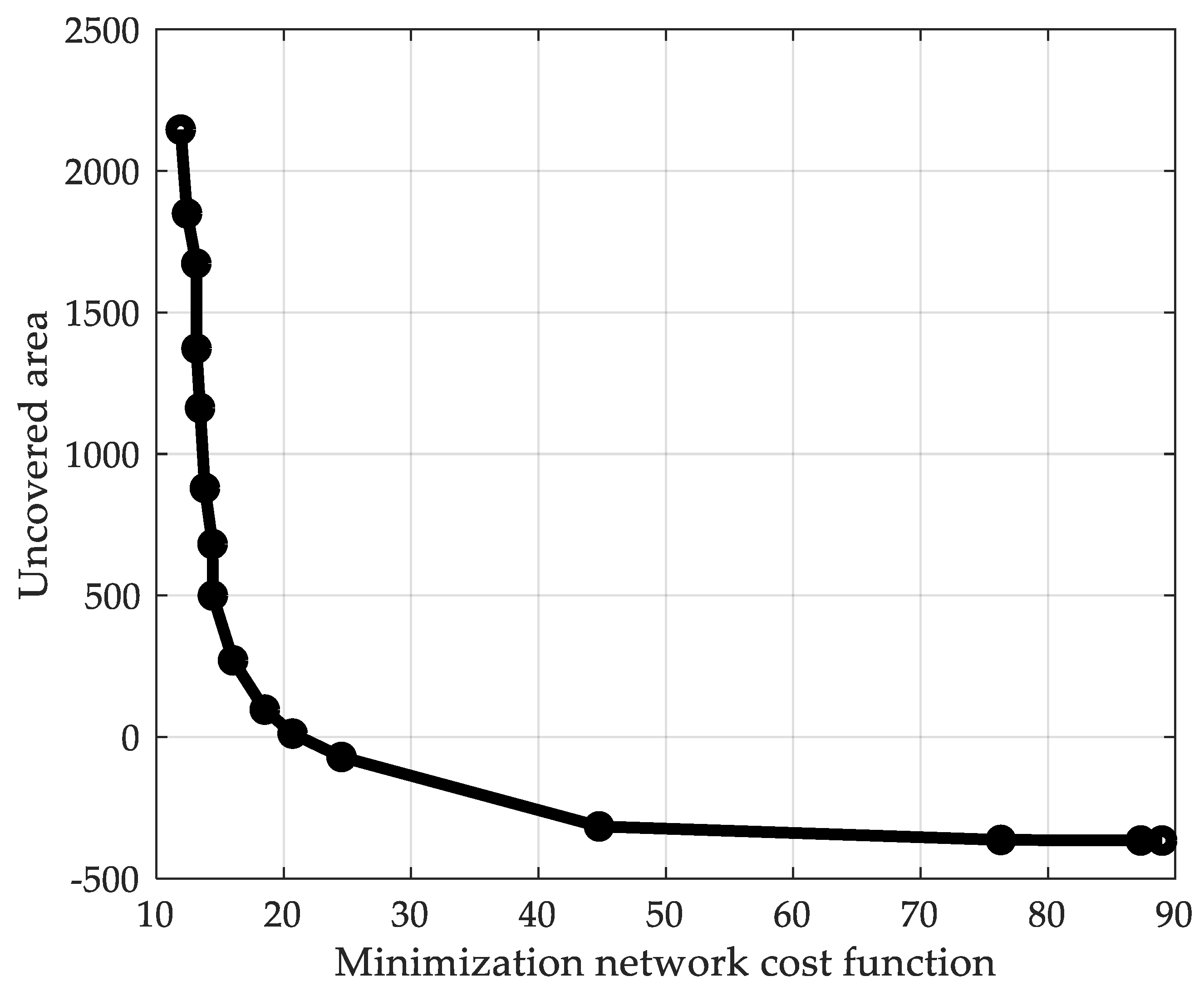2. Literature Review
The authors of a previous study [
5] proposed a method for infrared and camera sensor fusion, which was applied to indoor positioning in intelligent spaces. The fused position was obtained with a maximum likelihood estimator from the independent observations of infrared and camera sensors. However, the authors did not take into account the intersection of the sensors’ coverage areas. In [
6], a method for optimal coverage of the territory by sensors with different coverage radii was proposed. To solve this problem, the authors modified the least squares method. The criterion for optimality is the maximum coverage of the territory with a minimum intersection of coverage areas. The possibility of changing the intersection value and square of the uncovered territory was not mentioned. In [
7], an algorithm for an aerial sensor network composed of fixed-wing unmanned aerial vehicles that perform surveillance and detect the early signs of wildfire in a given territory was presented. The main goal was to cover a given area while prioritizing areas of higher fire hazard risk. The authors did not take into account the value of the uncovered area. The authors of [
8] focused on optimizing the placement of sensors to solve the problem of critical network coverage with two goals: accuracy and cost. However, the authors did not take into account the cost of the networks and elements of the networks. In order to enhance the network coverage range, in [
9], an instance (node) redeployment-based Bodacious-instance coverage mechanism (BiCM) was proposed. The proposed mechanism creates new instance positions in the coverage area; however, the authors did not take into account the uncovered area and the network’s cost.
According to the authors of [
10], the use of low-cost sensor networks is becoming increasingly popular in the environmental sciences, and the unprecedented amounts of monitoring data that are generated enable research across a wide spectrum of disciplines and applications. In [
11], a mechanism based on probabilistic blacklisting is proposed for Internet of Things networks, which results in lowering power consumption. In particular, channels suffering from non-negligible disturbance may be skipped based on the perceived quality of communication so as to increase the reliability and decrease the likelihood that retransmissions have to be performed. In [
12], the authors considered the optimization of the neighbor discovery to reduce the power consumption in wireless sensor networks and proposed an energy-efficient neighbor discovery scheme by adapting symmetric block designs, combining block designs, and utilizing the concept of activating nodes based on the multiples of a specific number. However, the network’s survivability was not mentioned. As shown in other research [
13,
14], modern sensor networks have become more and more expensive.
Due to the challenges of the modern technological world, survivability is an important parameter for information systems. Survivability is a property that characterizes the ability of a system to function effectively in the presence of damage or to restore this ability over a period of time. There is structural and functional survivability. A structure-based identification method to identify the influential nodes in industrial networks was proposed in [
15]. The authors only identified vulnerable nodes, but connections between nodes can also be vulnerable. The authors of [
16] present an approach to estimate the survivability of a sensor network based on Dijkstra and Lee algorithms; however, they did not take the bandwidth of network elements into account. The estimation of network viability using Markov chains is presented in [
17]. In this work, the sensor network’s survivability was not taken into account.
Table 1 presents a comparison of the studies found in the literature review, the main focus/outcome of the study and the factors that were not taken into account.
Based on the studies reviewed above, it can be concluded that the deployment of cost-effective sensor networks with the ability to assess survivability is an urgent problem.
3. Materials and Methods
A description of the notation used in this article is presented in
Table 2.
The task of maximizing the coverage of the sensor network while minimizing the cost and assessing the survivability will be solved in two steps. The first step is to find the optimal parameters of the network and territory coverage construction. The second step is an assessment of the survivability of the obtained network.
To find the optimal parameters of the network and for the construction of territory coverage, we consider an area of arbitrary shape with an area that is equal to
m
2. This area should be covered by sensors with a radius of coverage
r m. The coverage area of one sensor is denoted as
. The cost of the entire network will be equal to the number of network sensors multiplied by the cost of one sensor. The cost of the sensor is understood as the total costs associated with the purchase, operation and maintenance of the sensor. The cost of one sensor is denoted as
, and the area of the covered area as
. Thus, the task of minimizing the cost of the network with maximization of coverage can be presented as:
In Equation (1),
is the number of sensors, which is calculated as follows:
where
—area of the territory,
—the area covered by one sensor.
To find the exact number of sensors, the possibility of the intersection of the sensor coverage areas and the size of the uncovered area should be taken into account. Therefore, the coverage area of one sensor should not be considered as
. In our assumption, the coverage area of one sensor is calculated as the area of the square described around a circle with a coverage radius
as follows:
This assumption was introduced specifically to take into account the uncovered area around the sensor when calculating the number of sensors.
For example, we considered the case of coverage of the territory with four sensors with the intersection of coverage areas. This situation can be schematically represented as shown below in
Figure 1.
According to
Figure 1a, the value of the uncovered territory can be calculated as the difference between the area of a square with a side of
and the area of four segments with an angle of 90 degrees as follows:
In
Figure 1b, the value
is an intersection level of the sensors’ coverage areas. Taking into account value
, values covered by one sensor area Equation (3) and uncovered territory Equation (4) can be calculated as follows:
In Equation (6),
is the value of the area of intersection of the coverage areas with intersection level
. This value is equal to twice the area of the circle segment with radius
and chord
(
Figure 2).
Thus, the value of
can be calculated as follows:
where
,
, and
.
As the coverage of the territory is maximized, the area of the uncovered territory decreases. In this regard, the condition of maximizing the coverage in problem formulation (1) can be replaced by the condition of minimizing the uncovered area. According to this replacement and taking into account Equations (2)–(7), problem (1) can be formulated as:
The solution to the described problem is the set of Pareto optimal parameters of the coverage radius and the value of the intersection of the coverage areas of the sensors. Using the obtained parameters, the maximum coverage area is achieved at the minimum cost of the sensor network.
The second step after the network structure has been built with a designed approach, is the network survivability check. In [
16], an approach for estimating the survivability of a sensor network based on Dijkstra and Lee algorithms is presented. The total network survivability estimation as the probability of simultaneous occurrence of two independent events [
16,
18] is equal as follows:
where
is the sensor network survivability relative to the loss of communication between the sensors,
—count of weak connections,
—number of connections in the most important path,
is the sensor network survivability relative to the sensors’ loss,
—number of weak sensors,
—number of sensors in the most important path.
It is important to check the survivability in the case of sensor loss or connection loss. The bandwidth of the network elements is also a key and critical parameter of the network. We modified the algorithm described above to take the network bandwidth into account. We formed a connection importance matrix
, the elements of which are equal to:
where
,
and
—experts estimations of sensors
and
importance,
,
.
Depending on the type of communication and the data transmission protocol, the bandwidth of the communication channels in the sensor network will be different [
19]. It should also be borne in mind that different types of sensors may have different bandwidths, which may include the accumulation, reception, processing, and data transmission [
20]. The sensor bandwidth was denoted as
and the bandwidth of the communication channel between the two sensors as
,
,
,
—number of sensors. The values of
and
must be normalized—
,
.
In the case of different bandwidth of data channels, the elements of the connection importance matrix
(11) will be equal to:
where
,
,
—number of sensors.
Additionally, in the case of different bandwidths, the survivability of the sensor network can be estimated in case of loss of the sensor or communication channel that provides the best bandwidth. To make an assessment, we find the channels and sensors that provide maximum data flow with the Ford–Fulkerson algorithm [
21]. In our case, the result of using this algorithm will be a vector of network elements that provide the maximum data flow. The max flow sensors’ vector is denoted as
and max flow transition vector as
. Max flow value is denoted as
. The assessment of the survivability of the sensor network in case of loss of the sensor or communication channel is similar to the algorithm described in [
16]. The difference is in finding the value of the maximum flow. According to this, vectors
and
will contain elements in the absence of which the value of the maximum flow
is not reached. Estimates of the survivability of the sensor network in case of loss of the sensor or communication channel, providing the maximum bandwidth of the sensor network are as follows:
where
—number of elements in the weak connections vector
,
—number of elements in the
vector,
—number of elements in the weak sensors’ vector
,
—number of elements in the
vector.
Taking into account the estimates of the survivability of the sensor network relative to the loss of network elements that provide the maximum flow, the final assessment of the network’s survivability is as follows:
The value of will be equal to 1 in the case of equal bandwidth of communication channels. In turn, the value of will be equal to 1 in the case of equal bandwidth of the sensors.
Considering the case of sensors with different bandwidths and communication channels with equal bandwidth, it is difficult to find network elements that provide maximum data flow. This problem is due to the possibility that the sensors will have a bandwidth that is less than the bandwidth of the communication channel. To solve the described problem, an iterative procedure is proposed, which consists of assigning a bandwidth communication channel to the minimum bandwidth value of two sensors:
The next step is to change the value of the bandwidth of sensors using the communication channel
to a minimum value:
This procedure is performed alternately for each communication channel and for sensors involved in data transmission. Schematically, the algorithm can be represented by the following figure (
Figure 3).
The next method is to conditionally replace the sensor with two sensors connected by a communication channel with the bandwidth of the selected sensor. After solving the problem of finding the maximum flow and reverse replacement, we obtain sensors and appropriate communication channels that ensure maximum data transmission in the network. Schematically, this can be depicted as follows in
Figure 4.
In the case of different bandwidths in the sensors and communication channels, the above approaches are used to obtain a matrix of the bandwidth of the communication channels.
To sum up, the method of maximum coverage of the territory by sensors with the minimization of cost and assessment of survivability can be presented as shown in the flow chart in
Figure 5.
In the first stage after loading the territory, the area of the territory is automatically calculated. Next, the user must enter the input parameters, which include the radius of the coverage of the sensors and the minimum level of the intersection of the coverage areas. After the results are received in the form of Pareto-optimal pairs of the radius of coverage and the level of the intersection of the coverage areas, the user selects the required values. Then the coverage of the territory is built in accordance with the selected values of the parameters. Once the coverage is built, the survivability of the resulting network is assessed and vulnerable sensors and communication channels are searched. This procedure is available in two modes: taking into account the bandwidth of the network elements, and without taking into account the bandwidth of the network elements. The assessment results in five estimated values: the overall survivability of the network, survivability relative to the sensors’ loss, survivability relative to the loss of communication between the sensors, survivability relative to the loss of maximum bandwidth sensors, and survivability relative to the loss of maximum bandwidth connections. In the case of estimating the survivability of the network without taking into account the bandwidth of the network components, the corresponding estimates will be equal to one.
5. Discussion
Based on the developed method, appropriate cross-platform software was created. It finds the optimal parameters that achieve maximum network coverage at minimum cost and has the ability to assess the survivability of the network.
A genetic algorithm was used to solve the problem of finding the optimal parameters that provide maximum coverage at a minimum cost. The parameters of the genetic algorithm are: population size is equal to 200; tournament selection with size 2; reproduction with crossover fraction of 0.8; crossover function is intermediate with ratio of 1; forward migration with fraction of 0.2 and interval of 20; count of generations is equal to 200; stall generation is equal to 100; and the function tolerance is equal to
. The results are presented in
Figure 7,
Figure 8,
Figure 9,
Figure 10 and
Figure 11. The Pareto optimal combination of the coverage radius and intersection level, which can be used to find the maximum coverage with minimum network’s cost are presented in
Figure 7. The number of sensors with the appropriate coverage radius required to cover the area is shown in
Figure 8. One of the objective functions of the presented problem is the network cost function. The relationship between the uncovered area, the number of sensors, and the network cost’s minimization function is shown in
Figure 9 and
Figure 10. In
Figure 11, the cost of the network is shown depending on the coverage radius of the sensors costing 7 conventional units each.
After analyzing the results, we can conclude that increasing the radius of coverage decreases the number of sensors, which reduces the cost of the network. However, it should also be noted that increasing the radius of coverage leads to an increase in uncovered areas. To reduce the uncovered area, the cross-section of the sensor coverage areas should be taken into account. Therefore, the presented results allow you to choose the necessary network parameters depending on the needs and preferences of the user. According to
Figure 7, when the coverage radius is increased, less sensor nodes will be required, but increasing the radius of coverage requires an increase in signal strength and received signal strength indicators, which in turn leads to an increase in the energy consumption of the sensor. This fact must be taken into account when choosing the optimal combination of network parameters in the design.
According to the designed method, nearly zero uncovered area can be achieved by changing sensors’ coverage radiuses, intersection level, position of sensors (mobility of sensor nodes).
Analyzing the results of the assessment of the survivability of the incoming network (
Figure 12), we can conclude that the network is vulnerable, as its final survivability is 6%. This is due to the vulnerability of the network to the loss of sensors and communication channels between sensors. The components of the assessment are as follows: network survivability relative to sensor loss—50%, network survivability relative to communication channel loss—66.7%, network survivability relative to the loss of sensors that provide maximum information flow—25%, network survivability relative to channel loss communications that provide the maximum flow of information—71.4%. Half of all network sensors are vulnerable to the loss of elements that provide maximum data flow. To increase the survivability of the network, the user needs to add backup sensors and communication channels, as well as ensure the same bandwidth of all network elements.
According to the method presented in [
16], the total survivability of the network presented in
Figure 11 is equal to 33%. However, using the method presented in this article, the total survivability of the same network is equal to 6%. This means that the accuracy of estimating network survivability increased by 18% after taking the bandwidth of network elements into account.
Further research will be aimed at ensuring the possibility of using sensors of different radii at the same time during the construction of the coverage area. One of the areas of further research will be the development of a method to ensure the survivability of the network based on the assessment of survivability, calculated using the presented approach. As mentioned above, the topography is not accounted for and coverage is limited to a circular communication path around each sensor. In further research, topography will be accounted for. Taking into account the terrain will affect the geometry of the coverage area of the sensor, which will increase the accuracy of the coverage. Screenshots of the developed software are presented in
Figure 6 and
Figure 12. The software is not currently available to the reader and is developed in the form of a desktop application. One of the stages in the further development of the study is the improvement and presentation of software in a free access web application.
